Simulation Analysis of Three-Point Bending Fracture Process of Yellow River Ice
Abstract
:1. Introduction
2. Establishment of a Numerical Model for River Ice Fracture
2.1. Generation of Ice Crystals
2.2. Generation of Ice Grain Boundaries and Initial Defects
2.3. Constitutive Relation and Failure Criterion
2.4. Determination of Mesoscopic Parameters
3. Simulation Analysis of Three-Point Bending Fracture Process of River Ice
3.1. Analysis of Simulation Results
3.2. Analysis of the Impact of Crack-to-Height Ratio on the Three-Point Bending Fracture
3.3. Analysis of the Ice Crystal Size on the Three-Point Bending Fracture
4. Conclusions
- (1)
- Voronoi polygons are utilized to represent ice crystal grains, and a numerical model for simulating the fracture of river ice, accounting for initial defects, is established through secondary development using ANSYS software.
- (2)
- The cracking process of river ice under diverse loads is simulated. The three-point bending failure of river ice exhibits a typical wing-shaped crack, with an average error between simulated and experimentally obtained values of approximately 5%.
- (3)
- Based on the outcomes derived from the numerical simulations, an analysis is conducted to elucidate the impact of two pivotal factors—the crack-to-depth ratio and the size of ice crystals—on the fracture behavior of river ice. Within the confines of the simulated sample size spectrum, as the crack-to-height ratio varies from 0.2 to 0.8, the fracture toughness value of Yellow River ice spans a range from 115.01 to 143.37 KPa·m1/2. Correspondingly, within the simulated calculation values ranging from 5.38 mm to 24.07 mm for ice crystal size, the fracture toughness value of Yellow River ice exhibits a range from 116.89 to 185.54 KPa·m1/2.
- (4)
- The findings reveal that an increase in the crack-to-depth ratio leads to a decrement in the fracture toughness of river ice. Within the scale range encompassed by the model calculations, as the average size of ice crystal grains augments, the fracture toughness of river ice exhibits a gradual ascending trend.
Author Contributions
Funding
Data Availability Statement
Conflicts of Interest
References
- Chen, Z.T. Research on ice conditions of rivers, lakes, and seas in China. J. Glaciol. Geocryol. 1988, 10, 279–283. [Google Scholar]
- Chen, Z. Overview of the development of research on Yellow River ice observation. Yellow River Sci. Technol. Inf. 1989, 1, 15. [Google Scholar]
- Sun, Z.; Sui, J. Research on river ice jam and its significance. Adv. Earth Sci. 1990, 3, 51–54. [Google Scholar]
- Sui, J. Riverbed evolution during the freeze-up period in the Longkou-Tianqiao section of the middle Yellow River. Acta Geogr. Sin. 1992, 5, 209–219. [Google Scholar]
- Sui, J.; Fang, D.; Zhou, Y. Analysis and calculation of ice jam water level in the Hequ section of the Yellow River. Hydrology 1994, 63, 18–24. [Google Scholar]
- Wang, J. Experimental study on the incipient velocity of granular sediment under ice cover. J. Water Resour. Water Transp. Res. 1998, 2, 164–169. [Google Scholar]
- Wang, J. Experimental study on ice transport in balanced ice jam. J. Hydroelectr. Eng. 2002, 1, 61–67. [Google Scholar]
- Wang, J. Experimental study on the relationship between the thickness of balanced ice jam and flow conditions and ice discharge. J. Lanzhou Univ. (Nat. Sci.) 2002, 38, 117–121. [Google Scholar]
- Wang, J.; Fu, H.; Yi, M.; Yin, Y.; Gao, Y. Analysis of ice jam water level. Adv. Water Sci. 2007, 18, 102–107. [Google Scholar]
- Gu, L. Analysis of Ice Thickness during the Stable Freeze-Up Period and the Water Level during Ice Break-Up. Master’s Thesis, Hefei University of Technology, Hefei, China, 2007. [Google Scholar]
- Gao, G.; Ma, Z.; Li, S.; Deng, Y. Study on the influence of ice cover on the vertical velocity distribution of laminar flow. Yellow River 2018, 40, 15–17. [Google Scholar]
- Qin, J.; Shen, B. A new type of ice thickness sensor based on the electrical conductivity of ice and water. Sens. Technol. 2004, 23, 55–56. [Google Scholar]
- Qin, J. Theoretical and applied research on ice thickness detection based on the conductivity of air, ice, and water. Master’s Thesis, Xi’an University of Technology, Xi’an, China, 2005. [Google Scholar]
- Qin, J.; Cheng, P.; Qin, M. Ice thickness sensor and its detection method. Adv. Water Sci. 2008, 3, 418–421. [Google Scholar]
- Ji, H. Analysis of the Causes of Ice Jam Flooding in the Inner Mongolia section of the Yellow River and Research on the Forecast Model of Freeze-Up and Break-Up Dates. Ph.D. Thesis, Inner Mongolia Agricultural University, Hohhot, China, 2002. [Google Scholar]
- Wang, L.; Liu, J.; Xie, W. Research progress on ice jam forecast models in the Ningxia-Inner Mongolia section of the Yellow River. Yellow River 2014, 36, 8–10. [Google Scholar]
- Liu, J.; Huo, S.; Wang, C. Research on ice jam forecast and demand for ice prevention on the Yellow River. China Flood Drought Manag. 2017, 6, 10–13. [Google Scholar]
- Meng, W.; Liu, X.; Hu, J. Numerical simulation and experimental study on ice jam blasting based on cumulative penetration technology. J. North China Inst. Water Conserv. Hydroelectr. Power 2013, 3, 44–47. [Google Scholar]
- Yang, X.; Tong, Z.; Song, C. Research on blasting ice-breaking technology for disaster reduction during the ice jam period of the Yellow River. In Proceedings of the 125th Forum on Engineering Sciences and Technologies in China-Explosion Synthesis of New Materials and Key Science and Engineering Technologies for Efficient and Safe Blasting, Nanjing, China, 19 September 2011; pp. 297–303. [Google Scholar]
- Song, C.; Yang, X.; Yan, J.; Liang, Q.; Tong, Z. Research on ice-breaking technology using vehicle-mounted rocket explosion belt. Eng. Blasting 2013, 8, 50–53. [Google Scholar]
- Gao, G.; Deng, Y.; Tian, Z.; Li, S.; Zhang, B. Brief review and prospects of recent research on Yellow River ice jam. Yellow River 2019, 41, 77–81. [Google Scholar]
- Wang, E.; Xu, C.; Yu, J. Research progress on mechanical properties of freshwater ice in China. Water Resour. Sci. Cold Reg. Eng. 2019, 2, 37–43. [Google Scholar]
- Schulson, E.M. An analysis of the brittle to ductile transition in polycrystalline ice under tension. Cold Reg. Sci. Technol. 1979, 1, 87–91. [Google Scholar] [CrossRef]
- Nemat, S.; Horii, H. Rock failure in compression. Int. J. Eng. Sci. 1984, 22, 999–1011. [Google Scholar] [CrossRef]
- Wu, M.S.; Juan, N. Micromechanical prediction of the compressive failure of ice: Model development. Mech. Mater. 1995, 20, 9–32. [Google Scholar] [CrossRef]
- Wu, M.S.; Niu, J. Micromechanical prediction of the compressive failure of ice: Numerical simulations. Mech. Mater. 1995, 20, 33–58. [Google Scholar] [CrossRef]
- Korlie, M.S. 3D simulation of cracks and fractures in a molecular solid under stress and compression. Comput. Math. Appl. 2007, 54, 638–650. [Google Scholar] [CrossRef]
- Kendall, K. Complexities of compression failure. Proc. R. Soc. A Math. Phys. Eng. Sci. Lond. 1978, 361, 245–263. [Google Scholar]
- Evans, A.G.; Palmer, A.C.; Goodman, D.J.; Ashby, M.F.; Williams, G.J. Indentation spalling of edge loaded ice sheets. In Proceedings of the 7th IAHR Ice Symposium, Hamburg, Germany, 27–31 August 1984; Volume 1, pp. 113–121. [Google Scholar]
- Xiao, J.; Jordaan, I.J. Application of damage mechanics to ice failure in compression. Cold Reg. Sci. Technol. 1996, 24, 305–322. [Google Scholar] [CrossRef]
- Han, L.; Li, F.; Yue, Q.J. Finite element simulation of the entire process of ice cone interaction damage. China Offshore Platf. 2007, 22, 22–27. [Google Scholar]
- Cundall, P.A. A computer model for simulating progressive large-scale movements in block rock systems. In Proceedings of the International Symposium on Rock Fracture, Nancy, France, 4–6 October 1971; Volume 1, pp. 8–11. [Google Scholar]
- Jirasek, M.; Bazant, Z.P. Macroscopic fracture characteristics of random particle systems. J. Eng. Mech. 1995, 69, 201–228. [Google Scholar] [CrossRef]
- Jirasek, M.; Bazant, Z.P. Particle model for quasibrittle fracture and application to sea ice. J. Eng. Mech. 1995, 121, 1016–1025. [Google Scholar] [CrossRef]
- Lu, P.; Li, Z.J.; Han, H.W. Introduction of parameterized sea ice drag coefficients into ice free-drift modeling. J. Oceanol. 2016, 35, 53–59. [Google Scholar] [CrossRef]
- Wang, J.; He, L.; Chen, P.; Sui, J. Numerical simulation of mechanical breakup of river ice-cover. J. Hydrodyn. Ser. B 2013, 25, 415–421. [Google Scholar] [CrossRef]
- Yang, K. Research progress on river and canal ice hydraulics, ice observation, and forecasting. J. Hydraul. Eng. 2018, 49, 81–91. [Google Scholar]
- Fu, H.; Yang, K.; Guo, X.L.; Guo, Y.X.; Wang, T. Safe operation of inverted siphon during ice period. J. Hydrodyn. Ser. B 2015, 27, 204–209. [Google Scholar] [CrossRef]
- Mao, Z.; Ma, J.; She, Y.; Wu, J.J. Research on resistance of frozen rivers. J. Hydraul. Eng. 2002, 5, 59–64. [Google Scholar]
- Wang, J.; Huang, Y.; Deng, Y.; Zhijun, L.; Yaodan, Z. Research on ice fracture of the Yellow River performance based on digital image correlation method. J. Hydrol. 2021, 52, 1036–1045. [Google Scholar]
- Yaodan, Z.; Zhijun, L.; Yuanren, X.; Chunjiang, L.; Baosen, Z.; Yu, D. Microstructural characteristics of frazil particles and the physical properties of frazil ice in the Yellow River, China. Crystals 2021, 11, 617. [Google Scholar] [CrossRef]
- Yu, D.; Zongkun, L.; Juan, W.; Lukai, X. The microstructure of Yellow River ice in the freezing period. Crystals 2019, 9, 484. [Google Scholar] [CrossRef]
- Zou, B.; Xiao, J.; Jordaan, I.J. Ice fracture and spalling in ice structure interaction. Cold Reg. Sci. Technol. 1996, 24, 213–220. [Google Scholar] [CrossRef]
- Deng, Y.; Wang, J.; Xiao, Z. Selection of meso-parameters in the construction of a meso-model for river ice. Yellow River 2017, 10, 27–31. [Google Scholar]
- Dempsey, J.P.; Wei, Y.; Defranco, S.J. Notch sensitivity and brittleness in fracture testing of S2 columnar freshwater ice. Int. J. Fract. 1992, 53, 101–120. [Google Scholar] [CrossRef]
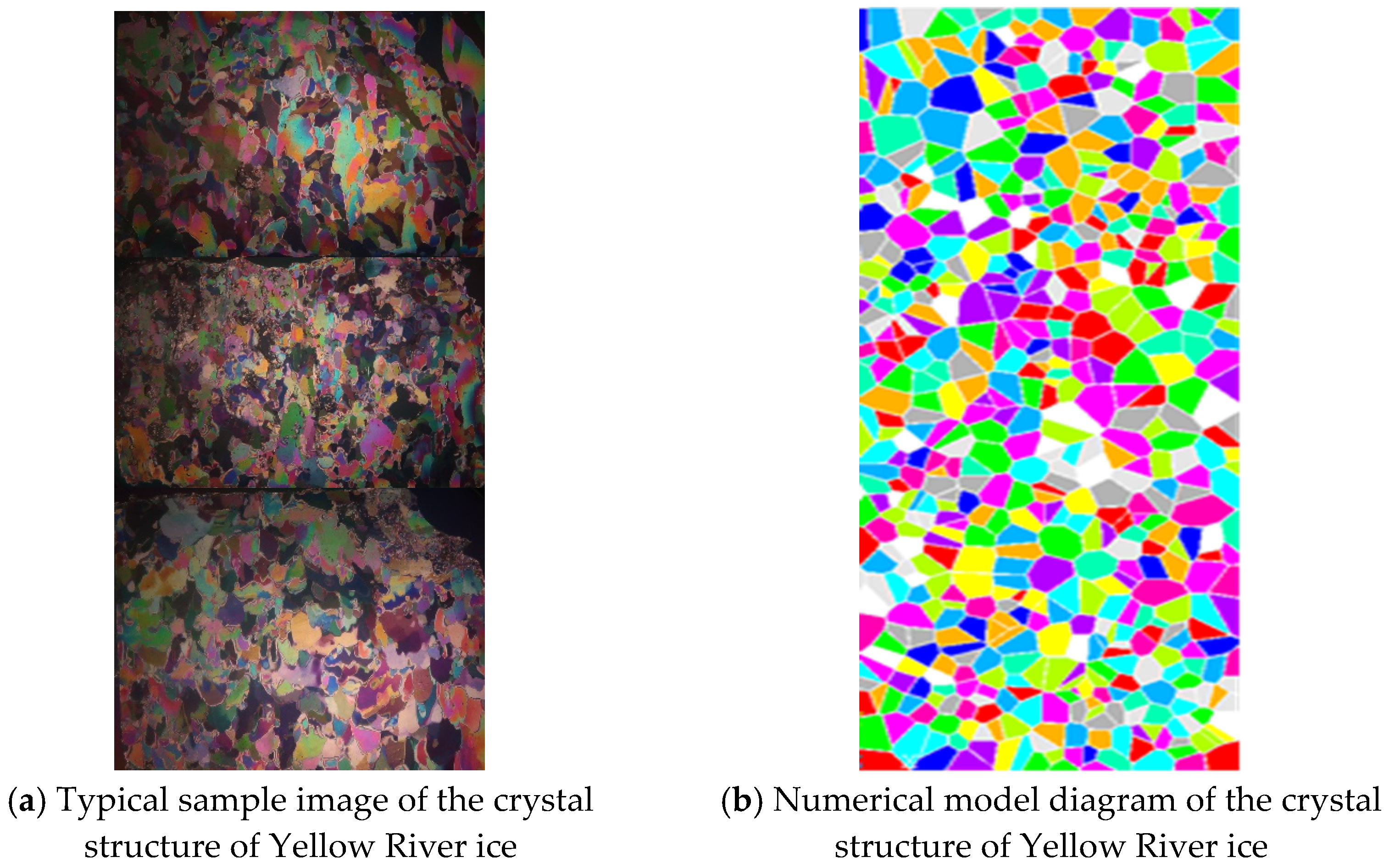

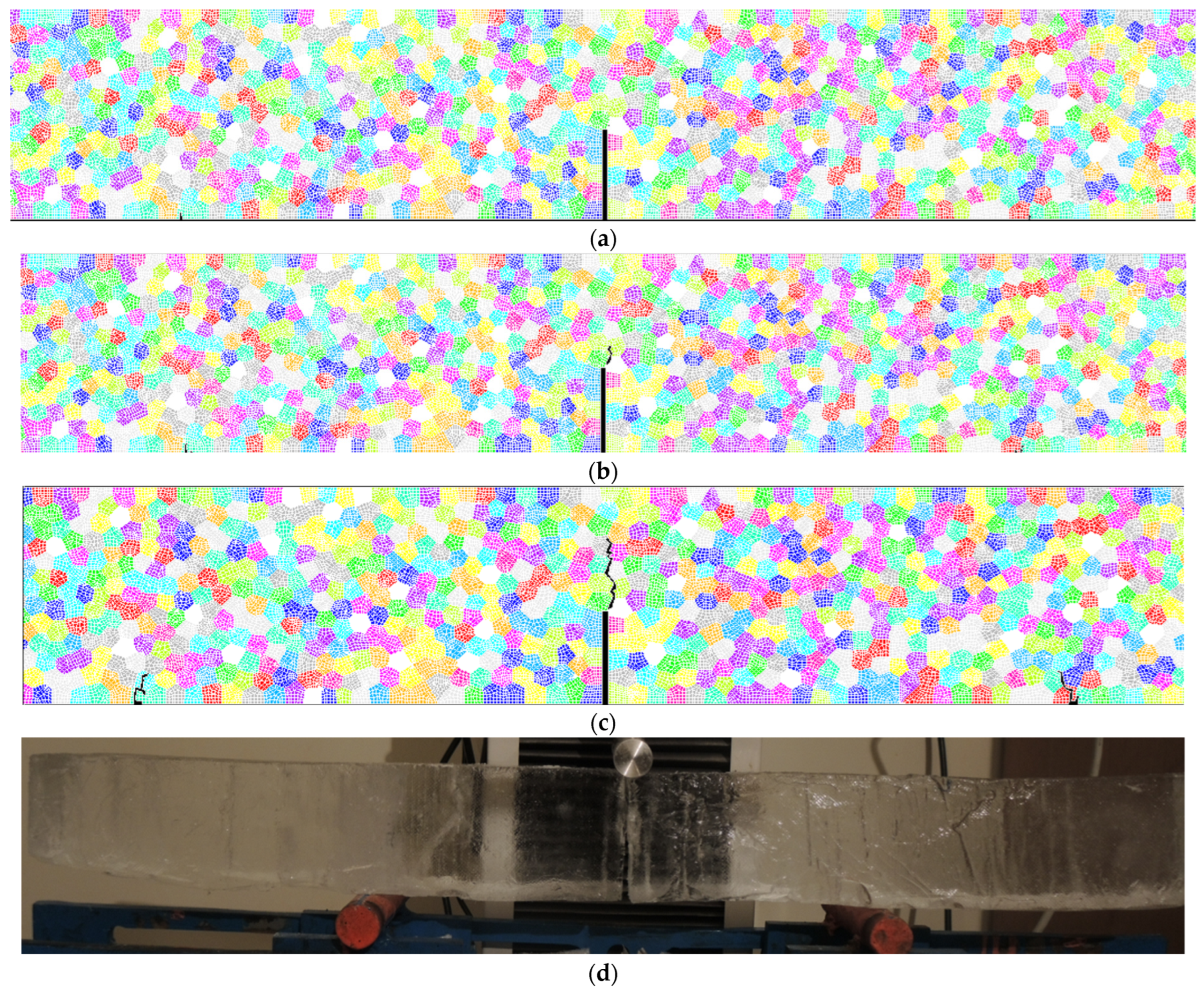
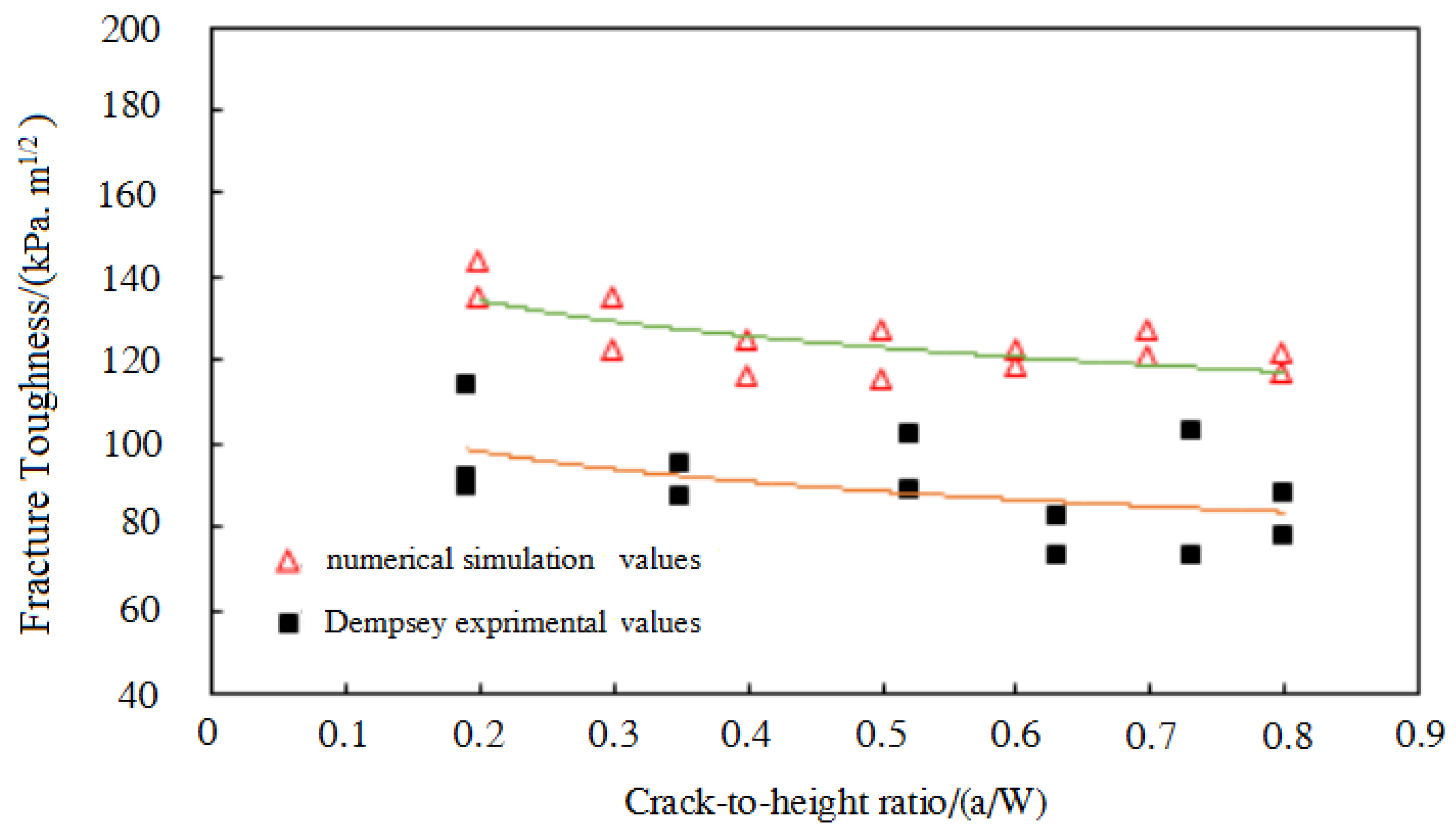
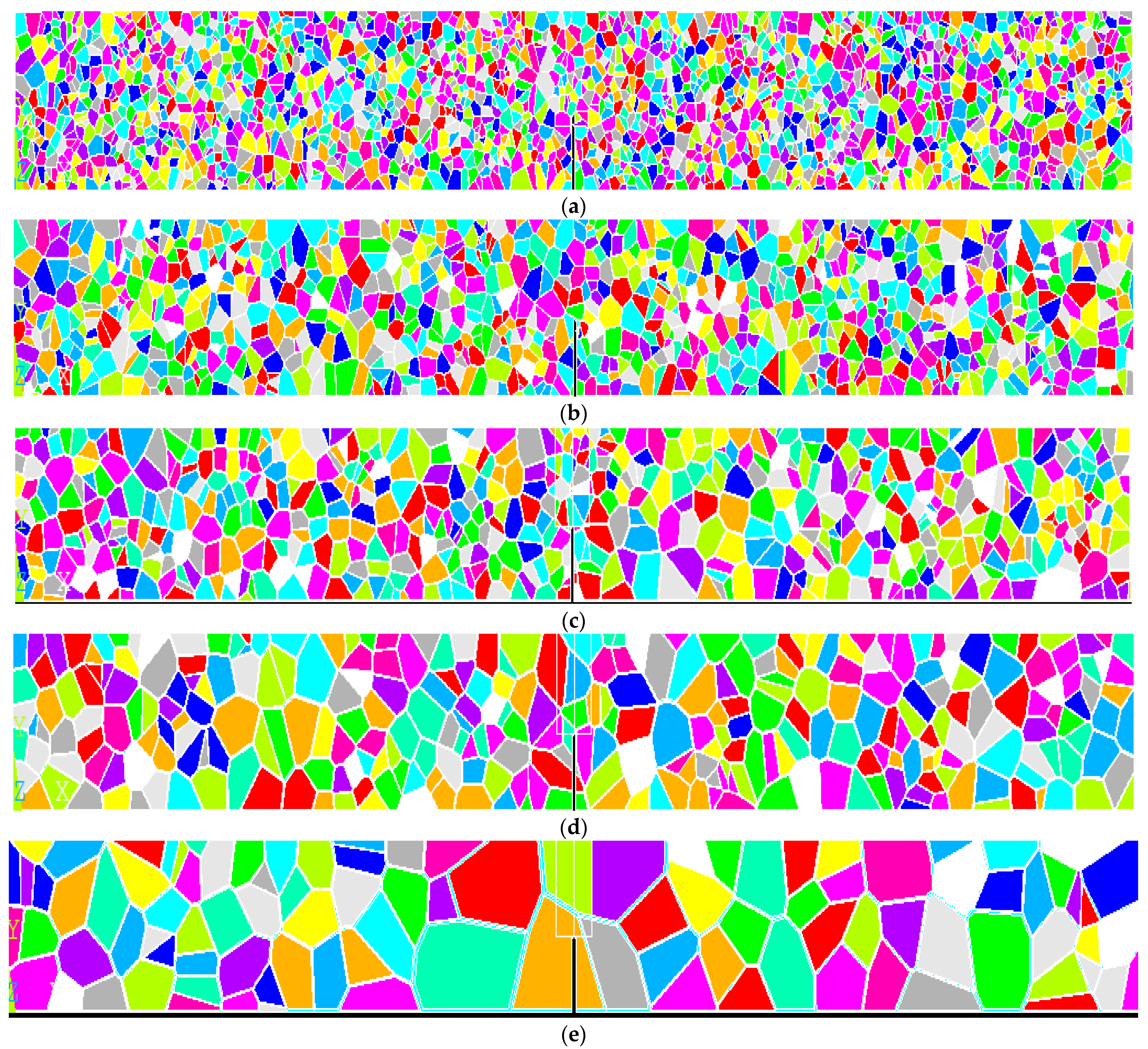
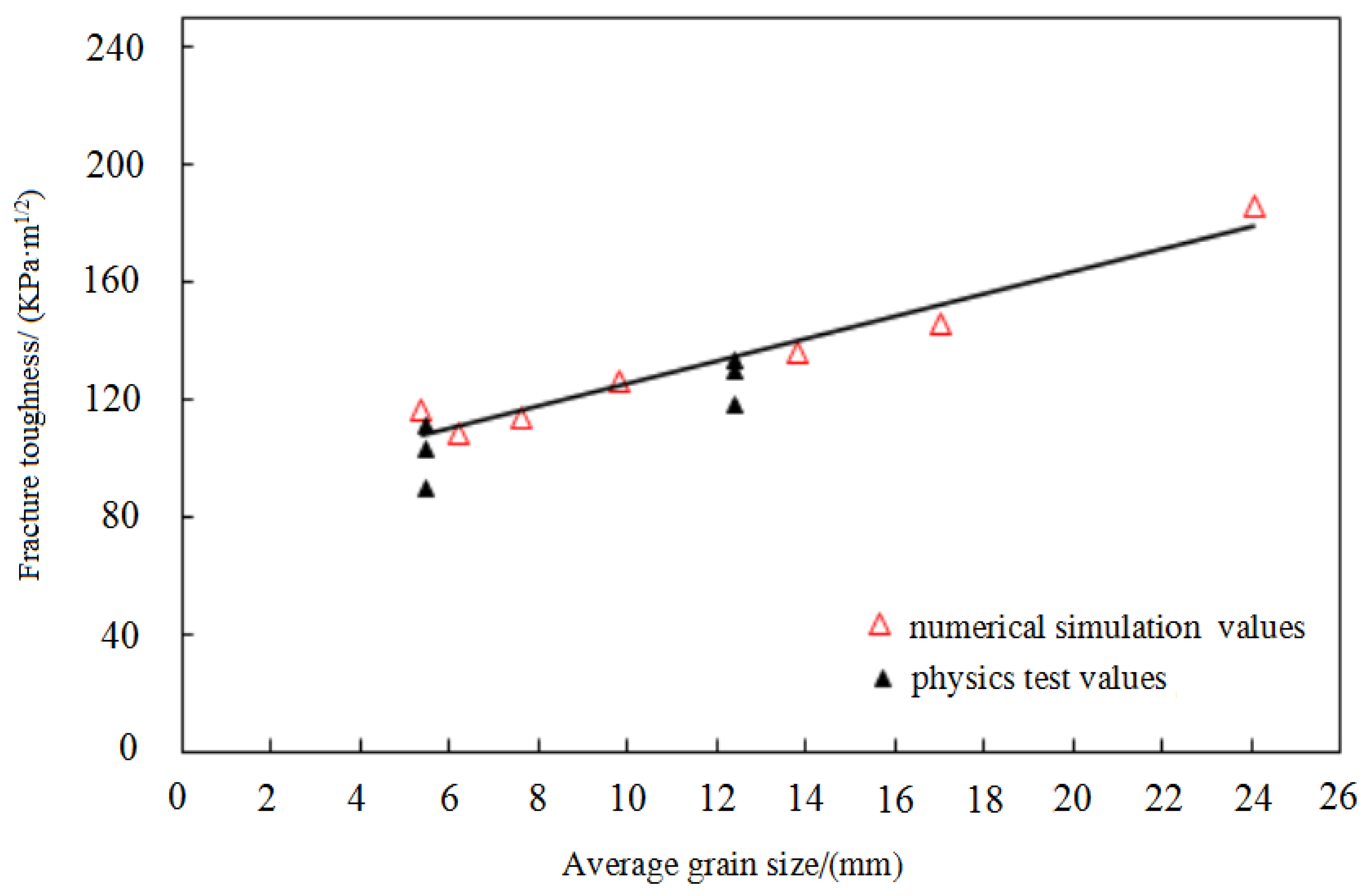
| Temperature (℃) | Strain Rate (s−1) | Grain Elastic Modulus (GPa) | Grain Strength (MPa) | Grain Poisson’s Ratio | Grain Boundary Elastic Modulus (GPa) | Grain Boundary Strength (MPa) | Initial Defect Content (%) | Grain Size (mm) |
|---|---|---|---|---|---|---|---|---|
| −10 | 10−4~10−5 | 9 | 1 | 0.3 | 5 | 0.5 | 6 | 2−10 |
Disclaimer/Publisher’s Note: The statements, opinions and data contained in all publications are solely those of the individual author(s) and contributor(s) and not of MDPI and/or the editor(s). MDPI and/or the editor(s) disclaim responsibility for any injury to people or property resulting from any ideas, methods, instructions or products referred to in the content. |
© 2024 by the authors. Licensee MDPI, Basel, Switzerland. This article is an open access article distributed under the terms and conditions of the Creative Commons Attribution (CC BY) license (https://creativecommons.org/licenses/by/4.0/).
Share and Cite
Deng, Y.; Wang, J.; Meng, Y.; Zhu, Y. Simulation Analysis of Three-Point Bending Fracture Process of Yellow River Ice. Crystals 2024, 14, 729. https://doi.org/10.3390/cryst14080729
Deng Y, Wang J, Meng Y, Zhu Y. Simulation Analysis of Three-Point Bending Fracture Process of Yellow River Ice. Crystals. 2024; 14(8):729. https://doi.org/10.3390/cryst14080729
Chicago/Turabian StyleDeng, Yu, Juan Wang, Yuhan Meng, and Yong Zhu. 2024. "Simulation Analysis of Three-Point Bending Fracture Process of Yellow River Ice" Crystals 14, no. 8: 729. https://doi.org/10.3390/cryst14080729





